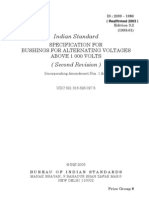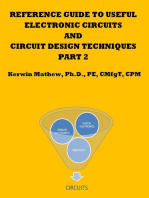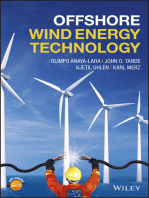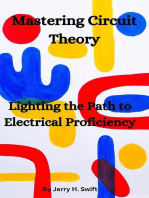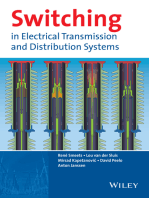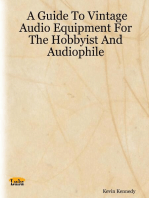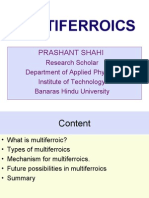0 ratings0% found this document useful (0 votes)
114 views1
1
Uploaded by
Achint KumarIS 10028
Copyright:
© All Rights Reserved
Available Formats
Download as PDF, TXT or read online from Scribd
1
1
Uploaded by
Achint Kumar0 ratings0% found this document useful (0 votes)
114 views15 pagesIS 10028
Original Title
10028_1
Copyright
© © All Rights Reserved
Available Formats
PDF, TXT or read online from Scribd
Share this document
Did you find this document useful?
Is this content inappropriate?
IS 10028
Copyright:
© All Rights Reserved
Available Formats
Download as PDF, TXT or read online from Scribd
Download as pdf or txt
0 ratings0% found this document useful (0 votes)
114 views15 pages1
1
Uploaded by
Achint KumarIS 10028
Copyright:
© All Rights Reserved
Available Formats
Download as PDF, TXT or read online from Scribd
Download as pdf or txt
You are on page 1of 15
( Reaffirmed 2001 )
IS I 10028 (Part l\ - 1985
I ndian Standard
CODE OF PRACTI CE FOR SELECTI ON,
I NSTALLATI ON AND MAI NTENANCE
OF TRANSFORMERS
PART 1 SELECTION
Transformers Sectional Committee, ETDC 16
Chairman
SERI c. R. VARI ER
Members
Repfescnling
Crompton Greaves Ltd, Bombay
SERI S. V. MANERI KAR (Alternate to
Shri C. R. Varier )
SHRI R. S. ARORA Directorate General of Supplies & Disposals
&RI D. R. CBANDRAN ( Alternate j
( I nspection Wing ), New Delhi
SHRI P. K. BHATTACHARYA Calcutta Electric Supply Corporation Ltd,
Calcutta
SHRI B. C. GHOSH ( Altcrnate )
DI RECTOR ( SUBSTATI ONS ) Central Electricity Authority, New Delhi
DEPUTY DI RECTOR
( SUBSTATI ONS ) ( Alternate )
SERI G. L. DI J A
SRRI S. C. KHUEANA ( Alternate )
Rural Electrification Corporation Ltd, New Delhi
SHRI A. R. DWARKANATH Madhya Pradesh Electricity Board, J abalpur
SERI N. N. BHARQAVA ( Alternate )
SHRI S. D. GUPTA Uttar Pradesh State Electricity Board, Lucknow
SHRI SATI SH KUMAR ( Alternate )
SHRI P. J . I N~LE Central Power Research I nstitute, Bangalore
SERI K. N. S. MURTHY (Alternate)
J OI NT DI RECTOR TI ( SUBSTATI ON ) Research, Designs & Standards Organization,
( Ministry of Railways ), Lucknow
D E P u T Y DI RECTOR STDS
SHRI R E~~~~t%! Alternate )
Bharat Bijlee Ltd, Bombay
S&x R. G. PARDHANANI ( Alternufc )
SHRI D. B. MEHTA Tata-Hydro Electric Power Supply Company Ltd,
SERI R. CHANDRAMOULI ( Alternate )
Bombay
( Continued on page 2 )
@J Copyright 1986
I NDI AN STANDARDS I NSTI TUTI ON
This publication is protected under the I ndian Cofiyrighr Act ( XI V of 1957 ) and
reproduction in whole or in part by any means except with written permission of the
publisher shall be deemed to be an infringement of copyright under the said Act.
IS : 10028 ( Part 1) - 1985
( CiWinucdJiom pagr 1 )
Mgmbcrs
SHRI VISHVAJI~ M. MEHTA
SE-RI D. V. NAXXE
Rcprtscnfing
Indian Transformer Manufacturers Association,
New Delhi
The General Electric Company of India Ltd,
Allahabad
SHXI B. A. SUBRAMANYAM (Alternote)
SHRI Y. K. PALVANKAR Bombay Electric Supply & Transport Undertaking,
SERI J. L. RODRIQ~ES ( Alternate )
Bombay
SHRI B. K. PATEL Gujarat Electricity Board, Vadodara
SHRI C. D. PANEL {Alternate )
DB G. M. PHADKE Indian Electrical Manufacturers Association,
Bombay
SHRI P. K. PHILIP ( Alfcrnatr )
DR K. V. N. RAO Electrical Research & Development Association,
Bombay
SHRI N. J, BUCH ( Altcrnatc )
SHRI CEANDBA K. ROHATQI Pradip Lamp Works, Patna
SHRI P. S. SAWHNEY Delhi Electric Supply Undertaking, New Delhi
SHRI S. P. AQ~ARWAL ( Alternate )
SHRI R. K. SEH~AL Bombay Suburban Electric Supply Ltd, Bombay -
Sam H. S. NATARAJAN ( Alternate )
SHRI K. G. SHANMUEHAPPA NGEF Ltd, Bangalore
SHRI MOEAMMED YOUSUFF ( Alternate )
SUPERINTENDING E N Q 1 N E E R Andhra Pradesh State Electricity Department
TECHNICAL ( PROJECTS ) ( Electricity Projects and Board ), Hyderabad
( SUPERINT~NDINQ ENQINEER
( GRID OPERATIONS ) ( Ahrnate )
SHRI I. 0. TAYAL
Bharat Heavy Electricals Ltd, New Delhi
Snnr R. S. SHAH ( Alternate I )
SHRI D. P. GUPTA (Alternate II )
DR VAKIL AHMED
Directorate General of Technical Development,
New Delhi
SHRI S. K. PALHAW ( Altsrnate )
SHRI T.V. VIDYARATNA RAJ
Kirloskar Electric Company Ltd, Bangalore
SHRI P. RANQARAJAN ( Altrreate )
SHRI S. P. SACHDEV,
Director General, IS1 ( Ex-o&o Member )
Director (Elec tech )
Secretury
SHRI K. M. BHATIA
Joint Director ( Elec tech ), IS1
Panel for Selection, Installation and Maintenance of
Transformers, ETDC 16/P 13
Convener
SERI C. R. VARIER
Crompton Greaver Ltd, Bombay
Members
SHRI S. V. MANERIKAR ( Altcrnatc to
Shri C. R. Varier )
SHRI M. M. BENDRE
Maharashtra State Electricity Board, Bombay
( Continued on page 13 )
2
CODE OF PRACTI CE FOR SELECTI ON,
I NSTALLATI ON AND MAI NTENANCE
OF TRANSFORMERS
IS:10028 (Part 1) -1985
I ndian Standard
PART 1 SELECTI ON
0. FOREWORD
0.1 This Indian Standard ( Part 1 ) was adopted by the Indian Standards
Institution on 21 May 1985, after the draft finalized by the Transformers
Sectional Committee had been approved by the Electrotechnical Division
Council.
0.2 The code of practice on installation and maintenance of transformers
was originally published in 1961 as IS : 1886, intended as a guide to
installation engineers, contractors and others engaged in.the installation
and maintenance of power and distribution transformers. It was revised
subsequently in 1967, with additional details regarding internal inspection
of transformers. Apart from the information concerning transformers
themselves, the code covered ancillary work, such as ventilation, cabling
and isolation of transformers.
0.3 The persent version of the code has been brought out to include
additional details, such as the criteria of selection of transformers and to
update the information in other respects. This code has been published
in the following three parts:
Part 1 Selection
Part 2 Installation
Part 3 Maintenance
0.4 Attention is drawn to IS : 10561-1983* which may also be referred to
for additional guidance for determination and selection of transformer
characteristics. Attention is also drawn to the Report of the Committee
for Standardization of the Parameters and Specifications of Major Items
of 400 kV Substation Equipment and Transmission Line Materials, issued
by the Central Electricity Authority in 1984.
-.
Application guide for power transforpers.
3
IS : 10028 ( Part 1 ) - 1985
0.5 In preparation of this standard, assistance has been derived from
Specification for power and distribution transformers issued by the
Central Board of Irrigation and Power, New Delhi.
1. SCOPE
1.1 This standard (Part 1 ) covers guideIines for selection of distribution
and power transformers covered by, IS : 1180 ( Parts 1 and 2)* and
IS : 2026 ( Parts 1 to 4 )t respectively for voltage ratings up to and
including 400 kV ( highest system voltage U, = 420 kV ).
2. TERMINOLOGY
2.0 For the purpose of this standard, the definitions given in IS : 1885
( Part 38 )-1977% shall apply.
3. GENERAL
3.1 The transformers covered in this standard are classified into the
following groups:
4
Distribution transformers ( up to and including 1 600 kVA),
b)
Power transformers ( above 1 600 kVA ),
c>
Generator transformers, and
4
Unit auxiliary and station transformers.
NOTE- The terms used here are not in line with IS : 2026 (Part l )-19770
where generator transformers, unit auxiliary and station transformers are covered in
the general category of power transformer. This distinction has been made in this
code of practice as the selection criteria is different for different groups.
*Specification for outdoor type three-phase distribution transformers up to and
including 100 kVA 11 kV:
Part 1 Non-sealed type ( second revision ).
Part 2 Sealed type.
tspecification for power transformers:
Part 1 General ( jrst revision ).
Part 2 Temperature-rise (first reuision ).
Part 3 Insulation levels ana dielectric tests ( second revision ).
Part 4 Terminal markings, tappings and connections (&t reui& ).
$Electrotechnical vocabulary : Part 38 Transformers ( jrst revi.rMn ).
@pecification for power transformers : Part 1 General ( first reuision ).
4
IS : 10028 ( Part 1) - 1985
3.2 The following should be considered as the main governing features
of each group of transformers for the purposes of selection:
4
Ratings,
b) Taps,
c>
Connection symbol,
4
Impedance,
4
Termination arrangement,
f-1
Cooling, and
d
Fittings and accessories.
4. CRITERIA FOR SELECTION OF DISTRIBUTION
TRANSFORMERS [UP TO AND INCLUDING 1600 kVA]
4.1 Ratings - The kVA ratings should comply with IS : 2026
( Part l )-1977*. The no-load secondary voltage should be 433 volts for
transformers to be used in 4 I5 V system. Voltage should be normally in
accordance with IS : 585-19627 except for special reasons when other
values may be used. For transformers requiring to be operated in
parallel, the voltage ratio should be selected in accordance with guidelines
given in 12.0.1 and 12.0.1.1 of IS : 10028 ( Part 2 )-1981$.
4.2 Taps -The transformers of these ratings are normally provided
with off-circuit taps on HV side except in special cases when on-load tap,
changers are specified. The standard range for off-circuit taps which
are provided on HV side should be f 25 percent and f 5.0 percent. In
case of on-load tap changers, the taps may be in steps of 1.25 percent
with 16 steps. The positive and negative taps shall be specified to suit
the system conditions in which the transformer is to be operated.
4.3 Connection Symbol - The two winding transformers should be
preferably connected in delta/ star in accordance with IS : 2026
( Part 4 )-1977s. The exact connection symbol ( Dyn 11 or Dyn 1 ) is to
be specified depending upon requirements of parallel operation with other
transformers in accordance with guidelines given in 12.0.1 and 12.0.1.1 of
IS : 10028 (Part 2)-1981: and 4 of IS : 10561-198311.
*Specification for power transformers: Part 1 General (Jr~t revision ).
tspecification for voltages and frequency for ac transmission and distribution systems
( reuiscd ) .
$Code of practice for selection, installation and maintenance of transformers:
Part 2 Installation.
BSpecification for power transformers : Part 4 Terminal markings, tappings and
connections (first reui si on ).
[IApplication guide for power transformers.
5
IS : 10028 ( Part 1) - 1985
4.4 Impedance - Consideration shall be given in the selection of
impedance for the standard available rating of the switchgear on the
secondary side and associated voltage drops. However, the impedance
values shall, as far as possible, conform to those specified in Table 3 of
IS : 2026 (Part 1 )-1977*. For transformers requiring to be operated in
parallel, the percentage impedance should be selected in accordance with
guidelines given in 12.0.1 and 12.0.1.1 of IS : 10028 (Part 2)-19817.
4.5 Termination Arrangement - The HV and LV terminals may be
bare outdoor bushings, cable boxes or bus trunking depending upon the
method of installation. Wherever compound filled cable boxes are used,
it is preferable to specify disconnecting chamber between transformer
terminals and cable box to facilitate disconnection of transformer
terminals without disturbing the cable connections (see also IS : 9147-1979:).
In case of extruded insulation cables with connections in air, a separate
disconnecting chamber is not necessary.
NOTE - A separate specification for cable end boxes for oil-immersed transformers
suitable for extruded insulated cables is under preparation.
4.6 Cooling - The transformers covered in this group are generally
ONAN, AN or ANAN cooled. Standard service conditions are given in 3
of IS : 2026 ( Part 1 )-1977*. For service conditions different from these,
selection of temperature-rise limits should be in accordance with
IS : 2026 ( Part 2 )-19775 or IS : 11171-1985~~ as appiicable.
4.7 Fittings and Accessories
4.7.1 For Oil Filled Transformers -The fittings and accessories should
be as specified in Appendix C of IS : 2026 ( Part 1 )-1977. Explosion
vent should be specified for all 11 kV transformers above 400 kVA rating
and all 33 kV transformers. When radiators are required to be detached
for transportation, isolating valves should be specified. Alarm and trip
contacts for oil temperature indicator, winding temperature indicator
and gas actuated relay may be specified when monitoring and control
devices are available for the transformer application.
4.7.2 For Dry Type Transformers - Fittings under serial No. 6, 12 and
15 of C-l and serial No. 1,6 and 7 of C-2 of IS : 2026 (Part l )-1977*
are not required for dry type transformers.
*Specification for power transformers: Part 1 General (Jirst revision).
tCode of practice for selection, installation and maintenance of transformers :
Part 2 Installation.
$Specification for cable sealing boxes for oil-immersed transformers suitable for
paper-insulated lead-sheathed cables for highest system voltages from 12 kV up to and
including 36 kV.
@pecification for power transformers: Part 2 Temperature-rise (Jirst revision ).
IjSpecification for dry type power transformers,
6
IS t 10028 (Part 1) - 1985
5. CRITERIA FOR SELECTION OF POWER TRANSFORMERS
( ABOVE 1 600 kVA)
5.1 Ratings - The secondary no-load voltage should be specified
5 percent more than the nominal voltage to compensate the transformer
regulation partly. For transformers requiring to be operated in parallel,
the voltage ratio should be selected in accordance with guidelines given
in 12.0.1 and 12.0.1.1 of IS : 10028 ( Part 2 )-1981*.
5.2 Taps - On-load tap changers on HV side should be specified,
wherever system conditions warrant. For interconnecting auto-
transformers with on-load tap changer, system conditions may warrant
tapping on low voltage side. In case of OLTC, the total number of taps
should be 16 in steps of 1.25 percent. The distribution on positive and
negative taps shall be decided to-suit the system conditions. Off-circuit
taps, when specified, should be in the range of f 2.5 percent and
f 5 percent provided on the HV side.
5.3 Connection Symbol - The preferred connections for two winding
transformers up to 66 kV high voltage ( HV ) side rating are delta/ star
( Dyn ) and star/ star ( YNyn ). For higher voltages, connections star/ star
( YNyn) or star/ delta ( YNd ) may be preferred. The selection of
connection group should be made taking into consideration the require
ments of parallel operation with other transformers as given in 12.0.1
and 12.0.1.1 of IS : 10028 ( Part 2 )-1981*. For transformers of ratings
up to 50 MVA, three limb ( Yyo ) construction, no stabilizing winding is
required unless the tertiary winding is required for auxiliary loads.
In
case of unloaded tertiary winding, one terminal should be brought out
for testing purposes.
5.4 Impedance - The transformer impedance is decided taking into
consideration the secondary fault levels and the voltage dip. The typical
impedance values are given in Table 3 of IS : 2026 ( Part 1 )-19777.
For transformers requiring to be operated in parallel, the percentage
impedance should be selected in accordance with guidelines given
in 12.0.1 and 12.0.1.1 of IS : 10028 (Part 2 )-1981*.
5.5 Termination Arrangement - Primary and secondary terminals
may be bare bushings, cable boxes or bus trunking depending upon the
method of installation. Wherever compound filled cable boxes are used,
it is preferable to specify disconnecting chamber between transformer
terminals and cable box to facilitate disconnection of transformer
*Code of practice for selection, installation and maintenance of transformers: Part 2
Installation.
tSpecification for power transformers: Part 1 General (first revision ).
Is : 10028 ( Part 1) - 1985
terminals without dismantling the cable connections ( see also
IS : 9147-1979* ). In case of extruded insulation cable connections in
air, a separate disconnecting chamber is not necessary.
NOTE -A separate specification for cable end boxes for oil-immersed trans-
formers suitable for extruded insulated cables is under preparation.
For transformers up to 33 kV, porcelain bushings and for trans-
formers of 66 kV and above, oil-filled condenser type bushings should be
specified. For installation in polluted atmospheres, the bushings should
be specified with extra creepage distances as given in IS : 2099-19737.
5.6 Cooling-The type of cooling may be ONAN, ONAN/ ONAF,
ONAN/ ONAF/ OFAF or OFWF. Standard service conditions are given
in 3 of IS : 2026 ( Part 1 )-1977$. For service conditions different from
these. selection of temoerature-rise limits should be in accordance with
IS : 5026 ( Part
recommended:
Rating
MVA
a) Up to 10
b) 12.5 to 40
c) 50 to 100
2 )- 19775. The following cooling arrangements are
Voltage Class
kV
Cooling Type Equipment
Up to 66 ONAN
Up to 132 ONAN ONAF
( 60 percent )
Up to 220 ONAN
ONAF One 100 percent
( 50 percent ) ( 62.5 bank with two
percent ) 100 percent
OFAN OFAF pumps (one
( 625 percent )
I
running and
one standby )
One standby fan or
two 50 percent
banks with two
100 percent
pumps.
(
one
running and
one standby )
*Specification for cable sealing boxes for oil-immersed transformers suitable for
paper-insulated lead-sheathed cables for highest system voltages from 12 kV up to and
including 36 kV.
tSpecification for bushings for alternating voltages above 1 000 V (first revision ).
2Specification for power transformers : Part 1 General (Jirst revision).
$Specification for power transformers: Part 2 Temperature-rise (jrst w&ion ).
8
IS : 10028 ( Part 1) - 1985
Rating Voltage Class
MVA kV
Cooling Type Equipment
Two standby fans,
one in each
50 percent bank
d) Above 100 Up to 400 ON AN
ONAF
~ (50 percent) (62.5
Same as for (c)
percent )
OFAN OFAF
( 62.5 percent )
OFAF>DAF Three 50 percent
OFAF coolers
0FW;;ODWF Two 100 percent
OFWF coolers
NOTE-. The manufacturer should be asked to confi rm the available rating
under complete failure of 50 percent cooling.
5.7 Fittings and Accessories - The fittings and accessories should be
as specified in Appendix C of IS : 2026 ( Part 1 )- 1977*. The following,
should in addition, be specified:
a)
b)
4
4
4
f>
d
4
3
Skids and hauling lugs;
Magnetic oil level gauge with low level alarm contacts;
Rollers ( bidirectional, if required ). If flanged rollers are
required, rail gauge should be specified;
Winding temperature indicator with electrical contacts for
alarm/ trip and controlling fans and pumps;
Gas and oil actuated relay with alarm and trip contacts. For
OLTC tank, a separate relay or other suitable protective device
may be specified;
Explosion vent;
Accessories for cooling arrangement;
Oil temperature indicator with alarm and trip contacts; and
Two sampling valves at tap and bottom of the main tank.
Specification for power ttmnsformers: Pat 1 General (first reuision ).
9
IS : 10028 ( Part 1) - 1985
6. CRITERIA FOR SELECTION OF GENERATOR
TRANSFORMERS
6.1 Ratings - The MVA rating of the generator transformer should be
at least equal to the full generator output without considering reduction
for unit auxiliary requirements. The no-load voltage of the secondary
winding should be specified about 5 percent more than the nominal
value to compensate the transformer regulation partly.
6.2 Taps - The generator transformers are normaly provided with off-
circuit tap changers except in cases where the system conditions warrant
use of on-load tap changers. The standard range for off-circuit tap
changer is 2.5 percent to 7.5 percent in steps of 2.5 percent. For 400 kV
transformers, on-load/ off-circuit taps should have tapping range of f 5
percent in steps of & 2.5 percent.
6.3 Connection Symbol - The preferred connection symbol for two
winding transformers is YNd 11 or YNd 1 with the star neutral solidly
earthed.
6.4 Impedance -The standard impedances are 12.5 to 14 percent with
tolerance as given in IS: 2026 ( Part 1 )-1977*. The exact value is to be
specified based on short-circuit level.
6.5 Termination Arrangement - The generator side LV terminals
should be suitable for bus duct or cable connection. The HV side
should have bare bushings suitable for outdoor installation. For 66 kV
and above, oil-filled condenser type bushings should be specified. For
installation in polluted atmospheres, the bushings shall be specified with
extra creepage distance as given in IS : 2099-19737.
6.6 Cooling --The type of cooling may be ONAN, OFAF or OFWF.
The temperature-rise limits should be as given in IS : 2026 ( Part 2 )-1977:
( see 5.6 ). Following cooling arrangements are recommended:
Rating Voltage Class
MVA kV
Cooling Type Equipment
Up to 250 Up to 400 ONAN ONAF
d5FoApNrcen1
(6ziz;rcent)
(62.5 percent)
OFAF&AF
OFWFZDWF
*Specification for power transformers: Part I General (jrst revision).
tSpecification for bushings for alternating voltages above 1 000 volts (first reuision ).
$Sprcification of power transformrrs: Part 2 Temperature-rise (first wision ).
10
IS : 10028 ( Part 1) - 1985
6.7 Fittings and Accessories - The fittings and accessories should be
as specified in Appendix C of IS : 2026 ( Part 1 )-19771. The following
should, in addition, be specified:
a) Magnetic oil level gauge;
b) Gas and oil actuated relay;
c) Explosion vent;
d) Winding temperature indicator with electrical contacts for
alram/ trip and controlling fans and pumps;
e) Skids and hauling lugs;
f) Rollers ( bidirectional, if required ). If flanged rollers are
required, rail gauge should be specified; and
g) Accessories for cooling arrangement.
7. CRITERIA FOR SELECTION OF AUXILIARY AND STATION
TRANSFORMERS
7.1 Rating - The voltage rating should be specified in such a manner
that the secondary voltages are about 5 percent more than the nominal
voltages to compensate the transformer regulation.
The auxiliary loads of thermal power stations require two voltage
levels. The high voltage level is 3.3 kV, 6.6 kV or 11 kV ( 6.6 kV
being the preferred value ) and the low voltage level is 415 V.
The number of unit auxiliary transformers ( UAT ) is one or two
depending upon the capacity of the unit. The number of station
transformers depends on the total number of generators in a power
station. It is normal practice to provide one station transformer up to
two units and two station transformers for two to five units.
The capacity of the unit auxiliary transformers is based on the
total actual running auxiliary load of the particular unit with
a 10 percent margin. If there are two auxiliary transformers per unit,
each unit transformer should be rated for minimum 55 percent of the
actual running auxiliary load of the unit.
7.1.1 The capacity of the station transformers should meet the
following requirements:
a) All running auxiliaries for station services at full station load;
*Specification for power transformers: Part 1 General (first revision ),
m : 10028 (Part 1) - 1985
b) The running auxiliaries of one unit bus at full load in the event
of outage of one UAT at a time in the power station; and
c) The auxiliary starting or coasting of another unit which may be
taken as 40 percent of the normal auxiliary load.
7.2 Taps -The UATS are normally provided with off-circuit taps
with f 2.5 percent and f 5 percent on HV side.
The station transformers are preferably provided with OLTC
with f 10 percent in steps of 1.25 percent on HV side.
7.3 Connection Symbol -The UATs are connected in delta/ star or
delta/ delta. In case of delta/ star, the star neutral is earthed through a
resistor.
The station transformers are connected in star/ delta or star/ star.
In case of star/ star, neutral on LV side is earthed through a resistor.
7.4 Impedance - The impedance is specified taking into consideration
the fault level of the auxiliary switchgear and the voltage dip during
starting of large motors. Also for station transformers with two
secondaries, the impedance shall be specified to limit the fault levels.
7.5 Termination Arrangement - The HV and LV terminals of the
UATs should be suitable for bus duct or cable connection.
The HV terminals of the station transformer are to be bare
bushings suitable for outdoor installation. For rating 66 kV and above,
oil filled condenser type bushings should be specified. For installation in
polluted atmosphere, bushings should be specified with extra creepage
distance in accordance with IS : 2099-1973*. The LV terminals should
be sui&abk for cable or bus duct connection.
The LV neutrals of UAT and station transformer, wherever
applicable, should be brought out for connection to neutral earthing
resistor.
7.6 Cooling -The UATs may be ONAN or ONAN/ ONAF cooled
(ONAN rating of 50 percent ).
The station transformers may be ONAN or ONAN/ ONAF ( with
ONAN rating of 60 percent ) or ONAN/ OFAF ( with ONAN rating
of 50 percent ).
7.7 Fittings and Accessories - The fittings and accessories should be
as specified in Appendix C of IS : 2026 ( Pat? 1 )-1977t with additional
fittings as specified in 5.7.
*Specification for bushings for alternating voltages above 1 000 volts (first rcvisien ).
$Specification for power transformerr: Part 1 General (Jirst revision ).
12
IStlOO!ZS(Partl)-MS5
( Continued from page 2 )
Membera Rsjresmting
SHRI P. K. BHATTACEA~YA Calcutta Electric Supply Corporation Ltd,
Calcutta
SHRI S. K. GHOSH ( Ahnutr )
CEI EF ENQI NEER ( ELECTRI OA&)-1 Central Power Works Department, New Delhi
SHRI A. MAJ UYDAR (Ylltcmatc )
SERI B. B. DABS Delhi Electric Supply Undertaking, New Delhi
SHRI Y. P. SAREEN ( Alternate )
SHRI G. L. DI J A Rural Electrification Corporation Ltd, New Delhi
Saar M. M. J OAQ. Voltage Limited, Bombay
SHRI B. L. RAWAT Bharat Heavy Electricals Ltd, Bhopal
.%a~ .C. M. SRI VASTAVA ( Alternate I )
SHRI S. C. VERMA ( Alternate II )
SHRI N. R. SANTEANAM Tata Consulting Engineers, Bombay
SHRI M. N. BAPAT (Alternate )
SHRI K. G. SHANXUXEAPPA NGEF Limited, Bangalore
SEBI K. V. J AYADEV ( Alternate)
SERI R. K. SEHQAL
Bombay Suburban Electric Supply Limited,
Bombay
SERI I . N. THI J KPAL Haryana State Electricity Board, Chandigarh
SEBI J , L. ARORA ( Alternate)
13
INTERl$iTION\AL SYSTEM OF UNITS ( SI UNITS)
Base Units
QUANTITY UNIT SYMBOL
m
kg
s /,
A
K
Length
metre
Mass
kilogram
Time
second
Electric current ampere
Ther~modynamic ,kelvin
temperature
LumjnQuS intensity I ~
candela cd
Amount of substance mole mol
I ,
Supplementary Unite
QIJANTITY UNI T SYMBOL
Plane angle radian, rad
Solid angle
steradian sr
DqF$e? Unjp ;,
- QU~NTXTY.
Force_ .I
JQw3y
Power
Flux
Flux density
Frequency
Electric conductance
Electromotive force
Pressure, atress
siemens
volt
Pascal
UNIT SYMBOL
newton N-
joule
J
watt W
weber Wb
tesla T
hertz HZ
s
V
Pa
DEFI NI TI ON
I N - 1 kg.m/ss
PJ - 1 N.m
I W -lJ /s
lWb= 1V.s
1 T = 1 Wb/ms
1 Hz - 1 c/s (s-r)
1s = 1 A/V
1 V - 1 W/A
1 Pa - 1 N/m
:
You might also like
- Practical Guides to Testing and Commissioning of Mechanical, Electrical and Plumbing (Mep) InstallationsFrom EverandPractical Guides to Testing and Commissioning of Mechanical, Electrical and Plumbing (Mep) InstallationsRating: 4 out of 5 stars4/5 (4)
- Indian Standard: Application Guide For Electrical Relays For Ac SystemsDocument16 pagesIndian Standard: Application Guide For Electrical Relays For Ac SystemsvenkateshbitraNo ratings yet
- A Guide to Electronic Maintenance and RepairsFrom EverandA Guide to Electronic Maintenance and RepairsRating: 4.5 out of 5 stars4.5/5 (7)
- Transformer 10028 - 1 PDFDocument15 pagesTransformer 10028 - 1 PDFAman Deep100% (1)
- Reaffirmed 2001Document23 pagesReaffirmed 2001rajkumarrakhra100% (1)
- Reaffirmed 2001Document23 pagesReaffirmed 2001hardeep08No ratings yet
- Fdocuments - in Is 8478Document11 pagesFdocuments - in Is 8478chandu1821No ratings yet
- Is 2026 4 1977Document35 pagesIs 2026 4 1977just_4_u_dear_in9549No ratings yet
- 2026 - 3r Specification For Power Trfo - Part 3Document45 pages2026 - 3r Specification For Power Trfo - Part 3Balamurugan ArumugamNo ratings yet
- Is 5613 1 1 1985Document30 pagesIs 5613 1 1 1985Heather CarterNo ratings yet
- Reaffirmed 2001Document7 pagesReaffirmed 2001Abhishek TiwariNo ratings yet
- Reaffirmed 2001Document88 pagesReaffirmed 2001joydeep_d3232No ratings yet
- I S 2099Document38 pagesI S 2099Hariprasad gantyalaNo ratings yet
- First Revision) : Indian StandardDocument7 pagesFirst Revision) : Indian Standardabhijeet210988No ratings yet
- Indian Standard: Specification For Earthing Transformers (Document11 pagesIndian Standard: Specification For Earthing Transformers (Gaurav AgarwalNo ratings yet
- Indian Standard: Application Guide For Voltage Transformers (Document16 pagesIndian Standard: Application Guide For Voltage Transformers (Pardeep KhosaNo ratings yet
- Is.9921.2.1982 IsolatorsDocument30 pagesIs.9921.2.1982 IsolatorspramitbaulNo ratings yet
- Is 5613-1-1 2002 Design of Overhead Power Lines Up To 11 KVDocument26 pagesIs 5613-1-1 2002 Design of Overhead Power Lines Up To 11 KVAlexis Fernandez CordovaNo ratings yet
- Is 2121 1-4 Earthing For Overhead LinesDocument45 pagesIs 2121 1-4 Earthing For Overhead LinesVivekKajlaNo ratings yet
- 2026 - 1 Specification For Power Trfo - Part 1Document46 pages2026 - 1 Specification For Power Trfo - Part 1Balamurugan ArumugamNo ratings yet
- Is 9921 5 1985 PDFDocument13 pagesIs 9921 5 1985 PDFsridharNo ratings yet
- 3842 - 4 Thermal Relay BisDocument25 pages3842 - 4 Thermal Relay Bissinghhouse7000No ratings yet
- IS 2026 Part 1Document46 pagesIS 2026 Part 1Narendra SinhaNo ratings yet
- Disclosure To Promote The Right To Information: IS 11171 (1985) : Dry-Type Power Transformers (ETD 16: Transformers)Document26 pagesDisclosure To Promote The Right To Information: IS 11171 (1985) : Dry-Type Power Transformers (ETD 16: Transformers)Anthony JamesNo ratings yet
- Is 6949-1973Document14 pagesIs 6949-1973ThirumalNo ratings yet
- Is-10162 Spacers and Spacer DampersDocument16 pagesIs-10162 Spacers and Spacer DampersPankaj GoyalNo ratings yet
- Reaffirmed 1996Document16 pagesReaffirmed 1996Ritesh kumarNo ratings yet
- Is 1255Document87 pagesIs 1255Mala Rani50% (2)
- Is 10162Document16 pagesIs 10162Amit TodiNo ratings yet
- Indian Standard: Specification For Power TransformersDocument30 pagesIndian Standard: Specification For Power TransformerspaulsumantaNo ratings yet
- Is 2026 - 3Document44 pagesIs 2026 - 3Gaurav Agarwal100% (1)
- Reaffirmed 1994Document10 pagesReaffirmed 19948085roNo ratings yet
- Indian Standard: Specification For High Voltage FusesDocument54 pagesIndian Standard: Specification For High Voltage FusesGaurav AgarwalNo ratings yet
- Is 8084 1976Document32 pagesIs 8084 1976Ramesh AnanthanarayananNo ratings yet
- Reaffirmed 1997Document17 pagesReaffirmed 1997Vineet VermaNo ratings yet
- Disclosure To Promote The Right To InformationDocument28 pagesDisclosure To Promote The Right To InformationduonzaNo ratings yet
- Is 5950-1984Document10 pagesIs 5950-1984Anish Mangalathu MohananNo ratings yet
- Indian Standard: Specification For Power TransformersDocument32 pagesIndian Standard: Specification For Power TransformersIsmaelNo ratings yet
- Switchgear Preventive MaintainanceDocument59 pagesSwitchgear Preventive MaintainancerkbcppNo ratings yet
- Is 7752 1 1975Document20 pagesIs 7752 1 1975vijay_raina3114No ratings yet
- Reference Guide To Useful Electronic Circuits And Circuit Design Techniques - Part 2From EverandReference Guide To Useful Electronic Circuits And Circuit Design Techniques - Part 2No ratings yet
- Introduction to Electricity Supply and Regulation in IndiaFrom EverandIntroduction to Electricity Supply and Regulation in IndiaNo ratings yet
- Variable Frequency Transformers for Large Scale Power Systems Interconnection: Theory and ApplicationsFrom EverandVariable Frequency Transformers for Large Scale Power Systems Interconnection: Theory and ApplicationsRating: 5 out of 5 stars5/5 (1)
- Power Electronics: Lecture Notes of Power Electronics CourseFrom EverandPower Electronics: Lecture Notes of Power Electronics CourseNo ratings yet
- Reference Guide To Useful Electronic Circuits And Circuit Design Techniques - Part 1From EverandReference Guide To Useful Electronic Circuits And Circuit Design Techniques - Part 1Rating: 2.5 out of 5 stars2.5/5 (3)
- Wideband RF Technologies and Antennas in Microwave FrequenciesFrom EverandWideband RF Technologies and Antennas in Microwave FrequenciesNo ratings yet
- A Guide to Vintage Audio Equipment for the Hobbyist and AudiophileFrom EverandA Guide to Vintage Audio Equipment for the Hobbyist and AudiophileNo ratings yet
- Grid Codes for Renewable Powered SystemsFrom EverandGrid Codes for Renewable Powered SystemsNo ratings yet
- Power Electronics and Energy Conversion Systems, Fundamentals and Hard-switching ConvertersFrom EverandPower Electronics and Energy Conversion Systems, Fundamentals and Hard-switching ConvertersNo ratings yet
- Generation and Transmission of Electric Power: Lecture Notes of the Generation and Transmission of Electric Power CourseFrom EverandGeneration and Transmission of Electric Power: Lecture Notes of the Generation and Transmission of Electric Power CourseNo ratings yet
- Analog Dialogue, Volume 48, Number 1: Analog Dialogue, #13From EverandAnalog Dialogue, Volume 48, Number 1: Analog Dialogue, #13Rating: 4 out of 5 stars4/5 (1)
- Wireless Power Transfer: Using Magnetic and Electric Resonance Coupling TechniquesFrom EverandWireless Power Transfer: Using Magnetic and Electric Resonance Coupling TechniquesNo ratings yet
- Protection of Substation Critical Equipment Against Intentional Electromagnetic ThreatsFrom EverandProtection of Substation Critical Equipment Against Intentional Electromagnetic ThreatsNo ratings yet
- Power System Transient Analysis: Theory and Practice using Simulation Programs (ATP-EMTP)From EverandPower System Transient Analysis: Theory and Practice using Simulation Programs (ATP-EMTP)No ratings yet
- Distribution of Electrical Power: Lecture Notes of Distribution of Electrical Power CourseFrom EverandDistribution of Electrical Power: Lecture Notes of Distribution of Electrical Power CourseNo ratings yet
- Wavelet Analysis and Transient Signal Processing Applications for Power SystemsFrom EverandWavelet Analysis and Transient Signal Processing Applications for Power SystemsNo ratings yet
- Corporate Identity Number (CIN) - U40109RJ2000SGC016483: S.N O. Name of Item Quantity (Approx)Document45 pagesCorporate Identity Number (CIN) - U40109RJ2000SGC016483: S.N O. Name of Item Quantity (Approx)Achint KumarNo ratings yet
- HyperlinkPublicNoticeforwebsite PDFDocument1 pageHyperlinkPublicNoticeforwebsite PDFAchint KumarNo ratings yet
- Charoong Thai Wire & Cable Public Company Limited: CTW - Aluminum RodDocument1 pageCharoong Thai Wire & Cable Public Company Limited: CTW - Aluminum RodAchint KumarNo ratings yet
- 33 KV Capacitor Bank February 2019 PDFDocument10 pages33 KV Capacitor Bank February 2019 PDFAchint KumarNo ratings yet
- Aluminum Round Bar 6082Document1 pageAluminum Round Bar 6082Achint KumarNo ratings yet
- Charoong Thai Wire & Cable Public Company Limited: Ctw-AcsrDocument6 pagesCharoong Thai Wire & Cable Public Company Limited: Ctw-AcsrAchint KumarNo ratings yet
- Charoong Thai Wire & Cable Public Company Limited: Ctw-AcsrDocument2 pagesCharoong Thai Wire & Cable Public Company Limited: Ctw-AcsrAchint KumarNo ratings yet
- Transmission Division Anjar Tender (Web) : Gujarat Energy Transmission Corporation LimitedDocument29 pagesTransmission Division Anjar Tender (Web) : Gujarat Energy Transmission Corporation LimitedAchint KumarNo ratings yet
- Acsr Astm B Aluminium Conductor Steel ReinforcedDocument10 pagesAcsr Astm B Aluminium Conductor Steel ReinforcedAchint KumarNo ratings yet
- Aluminum Round Bar 6082Document1 pageAluminum Round Bar 6082Achint KumarNo ratings yet
- Bus Bar Sizing Calcs - Substation and Switchboard - ExamplesDocument15 pagesBus Bar Sizing Calcs - Substation and Switchboard - ExamplesAchint Kumar100% (1)
- Insulation Coordination Studies For 400 KV Gis in A Hydroelectric Project in IndiaDocument6 pagesInsulation Coordination Studies For 400 KV Gis in A Hydroelectric Project in IndiaAchint KumarNo ratings yet
- Datacenter References Rev1Document13 pagesDatacenter References Rev1Achint KumarNo ratings yet
- FACTS CatalogDocument28 pagesFACTS CatalogAchint KumarNo ratings yet
- Siemens MCCB 3vlDocument6 pagesSiemens MCCB 3vlAchint KumarNo ratings yet
- KPN Data Center KPNDocument6 pagesKPN Data Center KPNAchint KumarNo ratings yet
- 7ss60x ManualDocument134 pages7ss60x ManualAchint KumarNo ratings yet
- Sentron 3WT BrochureDocument6 pagesSentron 3WT BrochureAchint KumarNo ratings yet
- 220kV PGCIL BUSBARDocument24 pages220kV PGCIL BUSBARJayam Harinatha Guptha100% (1)
- 7SG17 - Rho3 Complete Technical ManualDocument80 pages7SG17 - Rho3 Complete Technical ManualAchint KumarNo ratings yet
- Gis 72 800 KVDocument6 pagesGis 72 800 KVAchint KumarNo ratings yet
- FBTDocument2 pagesFBTAchint Kumar100% (1)
- On The Impact 0F Uni-Directional Forces On High-Voltage Towers Following Con Ductor-BreakâgeDocument10 pagesOn The Impact 0F Uni-Directional Forces On High-Voltage Towers Following Con Ductor-BreakâgebaybarsNo ratings yet
- 1.electric Charges and Fields: Jawahar Navodaya VidylayaDocument49 pages1.electric Charges and Fields: Jawahar Navodaya VidylayaRahul JRNo ratings yet
- 033-01 Bus Bar CRM MeggerDocument5 pages033-01 Bus Bar CRM MeggerRAM SHANMUGAMNo ratings yet
- Ckt3 Plate 2Document3 pagesCkt3 Plate 2'Wendell BernardinoNo ratings yet
- Comparison Between Vacuum and SF6 Circuit BreakerDocument9 pagesComparison Between Vacuum and SF6 Circuit BreakerMohammed MadiNo ratings yet
- Time-Dependent Analysis of Cable Domes Using A Modi Ed Dynamic Relaxation Method and Creep TheoryDocument12 pagesTime-Dependent Analysis of Cable Domes Using A Modi Ed Dynamic Relaxation Method and Creep TheorySparrow JackNo ratings yet
- Cad Lab ManualDocument1 pageCad Lab ManualRAM SINGHNo ratings yet
- Mitigation of Transient Recovery Voltages Using The SupercapacitorDocument6 pagesMitigation of Transient Recovery Voltages Using The SupercapacitorLuis ÁtilaNo ratings yet
- Duaso Test 1 40Document66 pagesDuaso Test 1 40John Louie PimentelNo ratings yet
- Activity 2.1.4 Calculating Force Vectors Answer Key: 5 sin 30 right 2.5 = = װDocument4 pagesActivity 2.1.4 Calculating Force Vectors Answer Key: 5 sin 30 right 2.5 = = װQuentin Andr (CoC)33% (6)
- Stability Draft Trim WorkbookDocument209 pagesStability Draft Trim WorkbookJoan Ramirez80% (5)
- Hydraulic Weld Force Gauge: For General Resistance Weld Compact, Lightweight, EasyDocument2 pagesHydraulic Weld Force Gauge: For General Resistance Weld Compact, Lightweight, Easykenneth lohNo ratings yet
- Cambridge International AS & A Level: Physics 9702/21Document14 pagesCambridge International AS & A Level: Physics 9702/21Taha Zia SyedNo ratings yet
- Hooke SLawDocument6 pagesHooke SLawDini IstiqomahNo ratings yet
- RT32044112019Document1 pageRT32044112019nar11No ratings yet
- Tertiary WindingDocument3 pagesTertiary WindingAtulya Kumar Naik100% (4)
- CEA Manual-TD PlanningDocument50 pagesCEA Manual-TD PlanningSaravanan Elumalai0% (1)
- Field (A) Electromagnetic Sheet 10th of RamadanDocument6 pagesField (A) Electromagnetic Sheet 10th of RamadanaboashoorNo ratings yet
- Multi 9: Protection in The Tertiary SectorDocument1 pageMulti 9: Protection in The Tertiary SectorWinSajeewaNo ratings yet
- GSIB 2080 Bridge Rectifiers 20A 200-800VDocument2 pagesGSIB 2080 Bridge Rectifiers 20A 200-800VZxdIaminxXzlovewithzxXzyouzxNo ratings yet
- MultiferroicsDocument21 pagesMultiferroicsprashantitbhushahi100% (3)
- Optical Fiber ModesDocument45 pagesOptical Fiber Modesnavyasanuj1No ratings yet
- Orbital ElementsDocument5 pagesOrbital ElementssamyalagarNo ratings yet
- Pe0380 PDFDocument39 pagesPe0380 PDFJhalak GuptaNo ratings yet
- N Detailed Modelling PDFDocument32 pagesN Detailed Modelling PDFhussain100% (1)
- Compact Realisation of PWM-VSL Current Controller ForDocument6 pagesCompact Realisation of PWM-VSL Current Controller ForpurplenazNo ratings yet
- Fastener AnalysisDocument57 pagesFastener AnalysisAnonymous 3B9kXrNo ratings yet
- Assignment No2Document11 pagesAssignment No2Aarish MaqsoodNo ratings yet
- Dr. B R Ambedkar NIT Jalandhar: Plasma Physics LabDocument14 pagesDr. B R Ambedkar NIT Jalandhar: Plasma Physics LabAditya TararNo ratings yet
- ElectricDocument40 pagesElectricnishant kumarNo ratings yet












